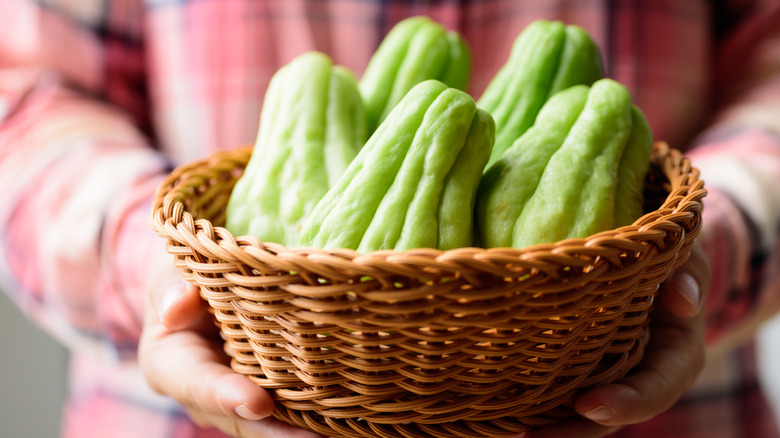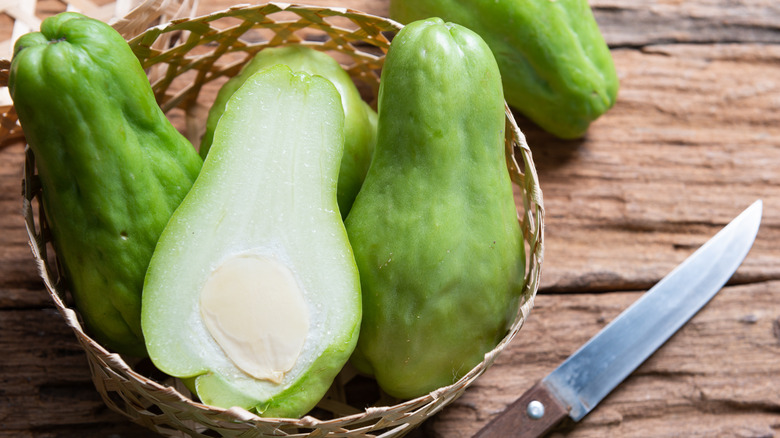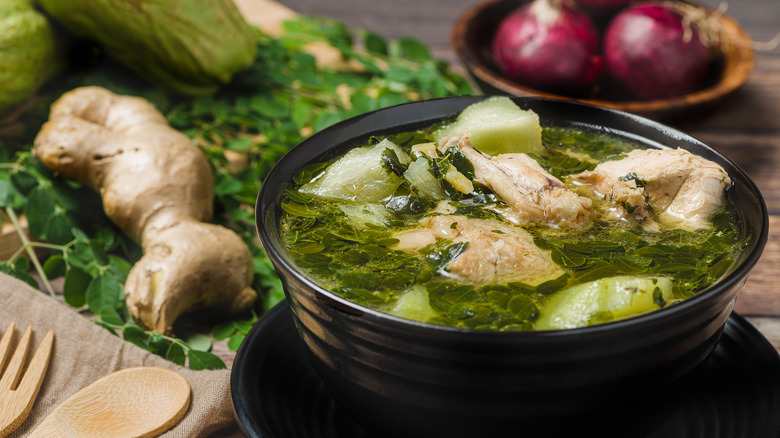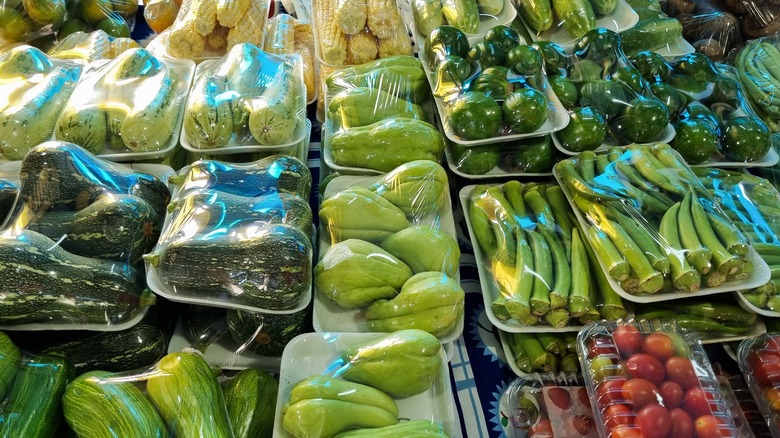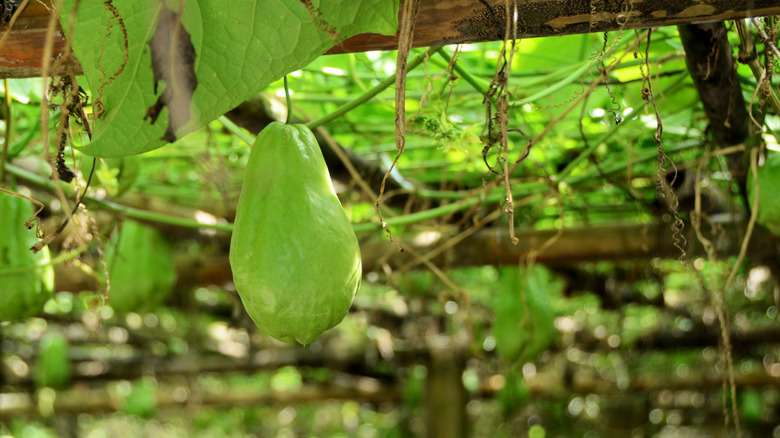The Uncommon Squash That Works Wonders In Almost Any Soup
Chayote squash is taking over the food scene with a mild, crisp flavor ready to handle any kind of recipe you toss at it. Native to Mexico, this fruit is popular in both Latin America and Asia, where it's eaten both raw and cooked. It's a member of the Cucurbitaceae or gourd family, making it a delicious summer squash with a bright green body in the shape of a large pear.
Chayote goes by many names, such as the vegetable pear, chocho, and mirliton. Although the smooth-skinned varieties are more common, there are several types that have small thorns along the outside, which make them difficult to peel. Also, essentially all types of chayote have an interesting type of sap that gets released as you peel it, which can cause mild irritation on the skin. It's not dangerous, but it does feel strange, like when super glue gets on your hands and causes the skin to tighten. Before peeling, you can rub oil onto your hands to prevent the water-based sap from affecting you.
It's hard to imagine a food more edible than chayote. You can eat the fruit meat, the pit in the middle, the skin, and the vines. Even the roots are edible, which are often cooked like a potato.
What does chayote taste like?
Though not nearly as sweet or acidic, raw chayote has a fresh, crunchy bite similar to a green apple, making it great for salads. And if you're running low on apples, feel free to toss some chayote into your next apple pie because these gourds can hang around the kitchen for weeks and grow year-round. They can also be enjoyed on their own, cubed and sprinkled with salt, or used to pack fiber into a smoothie.
Often compared to cucumbers and zucchini, chayote can be substituted for these vegetables in practically every case. Because of its crunchy texture and mild flavor, chayotes work best when added to soups. The hidden superpower of a chayote's mellow taste is that it absorbs flavors easily, and whether it's a beef, chicken, tomato, or veggie-based broth, complies well with the dish and gets pleasantly tender-crisp. Store-bought chayote can sometimes end up being a bit bland, so if you want to try chayote with a little more pop, consider growing some in your garden.
How to cook with chayote
Your options for cooking chayote are only limited by your imagination because it works well in dishes hot and cold, sweet and savory. For a fresh summer salad, peel, julienne, and mix it with other bright fruits and vegetables like tomatoes, feta, and cucumbers, and pour some bold raspberry vinaigrette on top. Chayote is a summer squash, so it goes well wherever other summer squashes might go. You can bake it in the oven, grill it, saute it, or put it in a tuna casserole. If you want something with a little more bite, hot pickled chayote is quite popular in Asian countries and well worth the effort of doing at home. To satisfy your sweet tooth, try that apple pie dupe, aka cinnamon chayote pie, or even Guatemalan chancletas, which is a chayote stuffed with almonds, breadcrumbs, sugar, and cinnamon.
But as we said, to get the most out of chayote, include them in hearty soups, like the classic Filipino chicken tinola which includes chicken, chayote, bok choy, ginger, and fish sauce. You can also purée it to make chayote soup (similar to a creamy butternut squash soup) or layer it into veggie-rich stews like ratatouille.
Where to buy chayote
Chayote is widely available and almost certainly at your local grocery store. Check in the produce aisle next to the other type of squash, and look for its bright green skin. If your local store doesn't have it available, you could try to look for it in an Asian or Latin American market, as chayote is popular in those cuisines. If all else fails, chayote can also be purchased from online produce retailers. If you love the taste of chayote and have room for it at your home, consider planting some in your garden. Chayote is prolific and doesn't require a lot of special care. You can buy a chayote at the store, bring it home, and use it to start your very own vine.
As was mentioned, there are different varieties of chayote. If you've enjoyed cooking with one variety, consider searching for other kinds. The chayote with thorns is a little more challenging to find and a bit of a pain to peel, but many have find the flavor worth the trouble.
Nutritional information about chayote
Would you believe it? Chayote is delicious and nutritious. According to Healthline, It's rich in calcium, vitamin B9 (aka folate), manganese, and vitamin C, to name just a few. One chayote squash typically has around 40 calories and 2 grams of protein with no fat, making it a light addition to any meal. Considering how many vitamins and minerals it carries, this fruit is highly nutrient-dense. Chayote is also rich in antioxidants, particularly myricetin, which has been shown to be anti-inflammatory and can reduce one's risk of developing high blood pressure, diabetes, and certain kinds of cancer. Chayote also contains the antioxidants quercetin, morin, and kaempferol.
Preliminary studies indicate that chayote could help fight fatty liver disease by removing fat from your liver. Its low-calorie count, paired with its high fiber content, helps with gut health and weight loss by keeping you full for longer. With all these health benefits, there's no reason not to give it a try.
